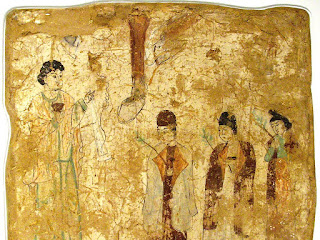middle ages etiketine sahip kayıtlar gösteriliyor. Tüm kayıtları göster
middle ages etiketine sahip kayıtlar gösteriliyor. Tüm kayıtları göster
5 Ekim 2021 Salı
1 Mayıs 2017 Pazartesi
Church of the East
Normally a topic as broad as part of the history of Christianity is way to large for a Fist of History post, but having read a fascinating book titled The Lost History of Christianity by Philip Jenkins recently I had to at least put out a small bit of information on such a fascinating, and unusual chapter of Christian history. In general the history of Christianity I'd learned could be broken up as follows:
- Originally the Papacy was one patriarch among many others in a Christianity that included the Byzantine Empire and Europe
- The Orthodox and Catholic traditions split over doctrinal issues and the Papacy ended up the head of European Christianity with the Orthodox heading up Christianity in North Africa and the Middle East
- Islamic conquests in the 7th and 8th centuries ended the Orthodox tradition, leaving the Papacy and European Christianity as the "winner" and the Orthodox church a smashed remnant of its former glory
The map above shows how extensive the geographic sweep of the Church of the East was at its height in the 8th century, covering the Persian Empire, Central Asia, parts of lower India, all the way out to China and Japan. At its height it was overseen by a Patriarch named Timothy I (727 to 823, Patriarch of the Church of the East from 780 to 823) considered himself on par with the heads of the Orthodox Church and the Pope based on the number of faithful, territory overseen, and influence wielded.
As a closing example of the odd loss of this history from our common story of Christianity, meet Rabban Bar Sauma, a Nestorian monk who was dispatched in 1287 by the Mongol overlord on a mission to recruit support for a combined Christian assault on Muslim Egypt. Sauma originated from China and, along with another monk named Markos, undertook a journey of diplomacy and religious pilgrimage into the Middle East. The two were able to travel safely through a network of monasteries and Christian communities that were part of the Church of the East for most of their journey. Sauma on his mission was allowed to participate in holy rites in Rome and the King of England took communion from him. This took place in the 13th century, when a "dream project" of a combined assault by Christian Mongols and Christian Europe on Islam was not only seen as possible but something that just needed to have the details worked out.
As you can probably guess though, things didn't work out and the Church of the East entered into decline and eventually all but vanished. Which leads to the final surprise, it remained viable and with high numbers of faithful up till the modern century in many areas. Small remnants of the faith remained hidden away throughout its former territory after prosecution, and within the Middle East sizable Christian communities remained in place until modern persecution finalized their destruction in the early to mid 20th century. Although the Church of the East had a long period of decline, it remained tenacious and portions of it remain in place even today.
Sources: Wikipedia entries on Timothy I, the Church of the East, Saint Thomas Christians, and Rabban Bar Sauma, It Happened Today entry on Rabban Bar Sauma, and The Lost History of Christianity, The Thousand-Year Golden Age of the Church in the Middle East, Africa, and Asia - and How it Died by Philip Jenkins (ISBN 978-0-06-147280-0)





